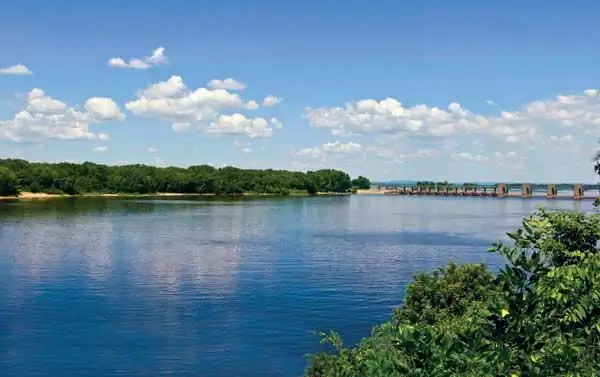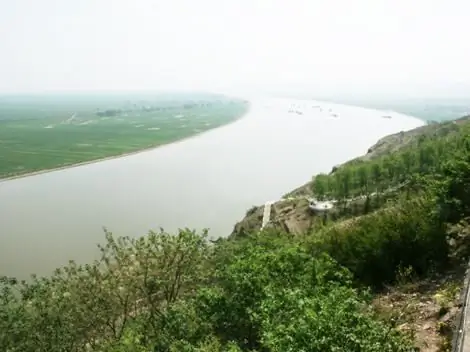History of mankind has always been directly connected with water bodies - it's not only about the origin, but also about the development of civilizations in river basins and off the coast of the seas. In the Middle Ages, powers with a fleet ruled the planet. To this day, the impact of water on human life is enormous. Therefore, the study of rivers can be not just a curious activity, but also a way to better understand the history of mankind and the relationship of different processes. First of all, you should pay attention to the largest, most famous and significant water flows of the Earth.
Nile
Although not the most full-flowing river in the world, but the longest, and therefore the most important. It is located on the African continent. The Nile is the longest - its length, together with the Kagera tributary, is 6671 kilometers. The river crosses the territory of Rwanda, Tanzania, Uganda, Sudan and Egypt, on the lands of the latter flowing into the Mediterranean Sea. The basin consists of two streams - the White and Blue Nile, and covers almost three thousand square kilometers. The main tributaries are the Sobat, the Atbara and the Bahr el Ghazal. One of the first civilizations known to mankind was born on the banks of the Nile, and at the same time, this river remained unexplored for a long time. Until the nineteenth century, travelers traveledacross the continent, trying to find the source, and this despite the fact that the Europeans made their first attempt back in 1613. Lake Victoria is also located in the basin, replenishing the river with water due to frequent rains in this area. A distinctive feature of the Nile is a large number of crocodiles - swimming in the reservoir is highly undesirable.

Amazon
Listing the great rivers of the world, it is impossible to forget about this one. The Amazon is the largest in South America, flows through the territories of Peru and Brazil, flowing into the Atlantic Ocean. Its name is associated with the legend of a warlike tribe of women who once lived on these shores. Their way of life was described by the traveler Carvajal, so vividly that there was no doubt about the authenticity of the stories. Europeans began to explore the largest rivers in the world during the Age of Discovery. In 1539, Pissarro arrived on the shores of the Amazon, trying to find gold. Hopes were not justified, but the Spaniards managed to explore the basin of an unfamiliar river with a strong current. The Amazon is the deepest river in the world. Its basin is almost seven thousand square kilometers. The river has about five hundred tributaries, forming a dense network, the most important are Purus, Zhurua, Madeira. The banks of the river are covered with impenetrable forests, and the world-famous piranha fish live in the waters.

Mississippi
For North Americans, this is the greatest river in the world. The Mississippi has many large tributaries - these are the Missouri, Illinois, Red River, Arkansas, Ohio. Many flow into the riverwater arteries. In Native American, the name of this hydronym means "father of the waters." The source is located in Lake Itasca, located in Minnesota. Like many other major rivers in the world, the Mississippi flows into the ocean - through the Gulf of Mexico. The shores are almost along the entire length protected by ramparts, in some places they are strengthened by dams. The mouth looks like a huge delta with six branches. The length of the river is almost four thousand kilometers. The Mississippi is fed by spring floods and floods caused by heavy rain. There used to be dense forest along the coast, but now there are many coastal cities.

Yangtze
Listing the largest rivers in the world, it is worth mentioning the one that flows through Asia. The Yangtze is the longest on the continent and the fourth longest on the planet. The length of the river is 5800 kilometers. The Yangtze flows through China and flows into the South China Sea, which belongs to the Pacific Ocean. The first Europeans who found themselves on the banks called the Blue River, but in fact the water in it is yellowish, with a lot of sand. The source is located in Tibet. The river is navigable for almost half of its length. At times of high water, the water level rises by a dozen meters, at such times the opportunities for sailing along the Yangtze increase. In winter, it becomes smaller, and shipping stops. Several reservoirs and dams have been built along the riverbed to prevent flooding. The Yangtze basin is extremely favorable for agriculture. The shores are fertile soils, so the locals are engaged hererice cultivation. Like other great rivers of the world, flowing into the sea, the Yangtze forms a vast delta of several tens of thousands of kilometers.

Ob
Listing the greatest rivers in the world, we must also mention the Russian one. The Ob flows through the west of Siberia and flows into the Gulf of Ob, which belongs to the Arctic Ocean. The source is located at the confluence of the Biya and Katun, and the mouth creates a delta several thousand square kilometers in size. Like other great rivers of the world, the Ob is very long - its length is almost four thousand kilometers. The tributaries include Vasyugan, Irtysh, Bolshoi Yugan and Northern Sosva, as well as Chumysh, Chulym, Ket, Tom and Vakh. On the banks is located the largest city in this area, Novosibirsk. In addition, the basin is known for several oil fields. The waters of the Irtysh are used to generate electricity, in addition, several large reservoirs have been created near it.

Huanghe
The great rivers of the world flowing through China are not limited to the Yangtze. There is also the Yellow River, which flows into the Yellow Sea and is part of the Pacific Ocean basin. The waters of the river are distinguished by a yellowish tint caused by a large amount of silt. The length is almost five thousand kilometers, thanks to which the river is in sixth place in the world. However, the Yellow River basin is relatively small. The river originates in the Tibetan Plateau, then flows along the Hetao Plain, along the Loess Plateau and the Great Plain of China, and then flows intointo the Bohai Bay, where it forms a delta. There are several large cities along the coast. However, living here is not too easy - the Yellow River regularly erodes dams, which leads to serious floods.

Mekong
It just so happens that the most famous rivers in the world are most often located in Eurasia. So the Mekong - the most important water artery of Indochina - flows there. It is the fourth longest river in Asia and the eighth on the planet. The basin passes through the lands of China, Laos, Burma, Cambodia, Thailand and Vietnam. The length is about four and a half thousand kilometers. The Mekong begins on the Tibetan Plateau, from where it heads to the Sichuan Alps, then to the east of the peninsula, ends up on the Kampuchean Plain and splits into several branches in the delta. The tributaries are Tonle Sap, Mun, Bassak and Banghiang. Before Phnom Penh, the water area is called the Upper Mekong, and then the Lower Mekong. The pool is ideal for navigation throughout the year. Uninterrupted movement is possible for seven hundred kilometers. The river is fed by monsoon rains from June to October.

Cupid
To complete the list of the most famous rivers in the world, this is worth it. The Amur serves as the border between China and Russia. From the source, its length is almost four and a half thousand kilometers. It flows into the Tatar Strait, located between the Sea of Japan and the Sea of Okhotsk. The area of the river covers 1856 square kilometers. The largest tributaries are the Tunguska, Zeya,Bureya, Amgun and Goryun, as well as Ussuri and Sungari. Amur is used as a transport highway, as well as for fisheries. In the waters, you can get twenty-five valuable species of fish: pink salmon, carp, salmon, sturgeon and others. The name of the river means "black water" in Mongolian. In the Far East, the Amur is considered the main water artery. Half of its basin falls on the territory of China. From July to September, the river is replenished with floods, sometimes they can become catastrophic. Some areas freeze in winter already from the beginning of November and are covered with ice until the very beginning of May.






